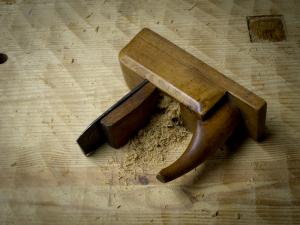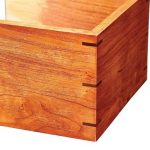We may receive a commission when you use our affiliate links. However, this does not impact our recommendations.
Years ago, I saw an interview with W. Patrick Edwards on how he dressed his benchtop with a toothing plane to improve his bench’s grip.
I was intrigued by his argument, but it took a few years until I was ready to commit to it.
Last year I toothed my benchtop and began working on that rough surface. Since then, I have become the No. 1 fan of the method. It is a quick process (less than four songs on the radio for an 8’ bench). It’s easy to do on a benchtop that has seen regular maintenance. And it definitely improves the grip of the benchtop.
Also worth noting: I haven’t added any finish to the benchtop since I first toothed it. This also seems to help improve its grip.
If you have a toothing plane or a plane with a toothing iron, I highly recommend you give it a try. If you don’t like it, the toothed surface is easy to remove with a bench plane.
Thanks Patrick. This is a genuine step forward for me and my workbench.
— Christopher Schwarz
The bench shown in the video is my 2005 French bench, built from Southern yellow pine. If you want to learn more about this bench – and how to build your own – my first book on workbenches is a good place to start. Check it out at ShopWoodworking.com.
And the song in the video is Langhorne Slim’s “Land of Dreams.”
Here are some supplies and tools we find essential in our everyday work around the shop. We may receive a commission from sales referred by our links; however, we have carefully selected these products for their usefulness and quality.










This is also a very “frenchy” thing to do on your bench!
Chris, I have a Roubo question. If the legs are mortised into the bottom of the bench top, isn’t wood movement in the top going to play havoc on the mortise and tenon joins and rack the short stretcher assemblies? I want to do a six foot bench to mount my recently acquired Emmert on and I am torn whether I want to do the beautiful through mortises or just to make the stretchers quickly and lag them to the bottom of the bench. By slotting the top could move and it would be much faster. Any thoughts?
Stevo
At the end of the video, is that the Schwarz version of ‘dropping the mic’? From here on out, that’s how I will show that I’m finished planing.
*shiiick* *shiiick* *shiiiick* *thud*
The advantages of fingerprints providing useful friction with three bark have just come into the news: http://www.bbc.co.uk/news/science-environment-21480654
Reading this, it could also have a bearing on why toothing the workbench surface works. The scientist involved is a Dr. Nathaniel Dominy. I don’t know if he is related to the the Dominy of the workshop and workbench fame at the Winterthur Museum, but it’s certainly a coincidence.
This post is perfectly timed- this week I am building a small bench and I was planning on flattening the top with a no.7 with a toothed blade. I might just leave the surface as is. I can always smooth it if it’s not working for me!
How do get on testing things for flat ie a board or some other component, I use my bench top as a reference, if something is rocking on my bench I will then test it on my planer bed, the toothed top with its dished look does not look seem very flat.
i thought you weren’t a fan of metal bench dogs…
Question: The scallops that I can see in the video – are they from the toothing plane or from a previous passes with a well-raidiused iron in a Jack or other plane that was used earlier? Or does your toothed iron have that big of a radius?
I don’t have a tooting plane, or much interest in one – but i surface my fir bench with fairly coarse cross-grain strokes. Not quite as rough, maybe, but it’s still a pretty effective alternative, depending n the species of wood.. And for folks timid about tooting their bench top, it’s a good way to convince themselves that rough is most definitely better.
The same effect as skinny tires giving better traction in slick snow. More psi bearing on the smaller contact area. Might have to try that. Would a piece of an old rip saw with the set flattened work?
Or screw down a piece of that OSB from the housing project dumpster!
Cool idea. I’m wondering, since I gave away a similar looking toothing plane (I thought it was for veneer work which I don’t do), can I use my Lie-Nielsen low angle jack plane with the toothed iron?
Interesting, I am curious though if you have ever had and adverse problems with the rougher surface? I have had it where you get a little particle af wood between the bench and your stock being held down via holdfast and ended up with dents from it, is this a problem with a toothed benchtop?
Did the benchtop have a finish prior to toothing? Or to ask it another way, did toothing an unfinished top improve the grip? I’m wondering if the unfinished portion of the equation is what really improved the grip. Maybe I’m way off but it would seem to me that grooving the top would create less ‘contact surface area’ for the board you are working and therefore less friction which would translate to less grip.